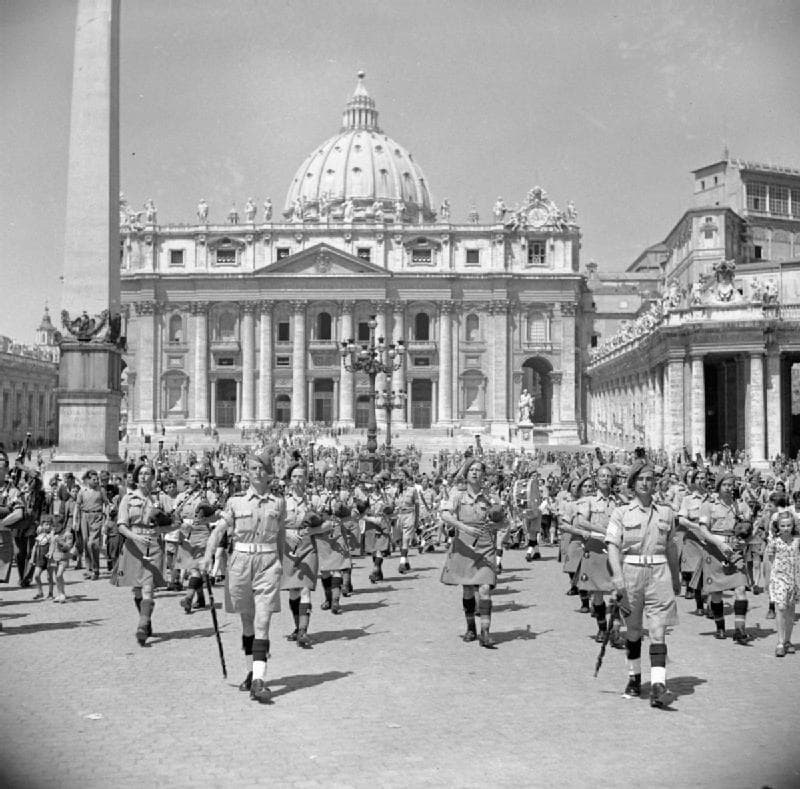LEICESTER, United Kingdom – The Vatican played a larger role in hiding escaped Allied POW’s during World War II than previously acknowledged, according to a new book on Britain’s top-secret agency dedicated to rescuing servicemen trapped behind enemy lines.
In MI9: A History of the Secret Service for Escape and Evasion in World War Two, Helen Fry documents not only how the United Kingdom’s embassy to the Holy See coordinated rescue efforts in the Italian theatre of the war, but how top-ranking Vatican officials assisted in these efforts.
The Vatican was officially neutral during World War II but Vatican City was located within the capital of Fascist Italy – the situation became even more precarious after the city was occupied by the Germans in 1943.
In the 1983 film The Scarlet and the Black, Irish Monsignor Hugh O’ O’Flaherty – portrayed by Gregory Peck – hides these prisoners despite resistance from Vatican authorities, who fear German reprisals against the city state.
O’Flaherty was a real person, but the Vatican’s role in assisting Allied personnel was downplayed in the dramatization.

The situation in the Vatican microstate was almost surreal: although most ambassadors to the Holy See live outside of Vatican City, during the war, the diplomatic corps relocated within the Vatican walls. The Union Jack could be seen flying at its diplomatic outpost, despite being deep within Axis territory.
O’Flaherty joined with British diplomat John May and Count Sarsfield Salazar, a British citizen serving as a POW camp inspector for the Swiss legation, to form the Rome Escape Organization.
However, they had friends throughout the Vatican, especially the Swiss Guards and Vatican Gendarmerie – the police force in the microstate – who would often house Allied servicemen in their barracks.
But the support of the escaped POW’s came from the highest levels. When Albert Penny, a seaman in the Royal Navy who escaped from an Italian POW camp, managed to sneak into Vatican City in 1942, he was allowed to stay for over two months, and even given access to the Vatican Gardens and had a private audience with Pope Pius XII.
“I waited for him in the Sala di Tronetto where he gave me his benediction. Conversing in English, which he did reasonably well, he said he was very pleased to be able to meet me and give me his blessing. He also gave me a rosary,” the sailor later recalled.
The Vatican arranged with the Italian authorities to have Penny flown to neutral Spain.
Penny’s was not an isolated case. As a neutral country, Vatican officials didn’t encourage Allied servicemen stuck behind enemy lines to enter the city state, but once they arrived, they were given every courtesy. Several met with Pius XII, and they stayed in the barracks of the Vatican Gendarmerie. When Rome was liberated on June 4, 1944, a dozen Allied servicemen were living in the city state, and scores more were hiding in Church-owned properties.

In addition, Vatican Radio sent coded messages to London about POW’s and the Vatican Bank loaned needed lira to the British legation money to fund the Rome Escape Organization.
Speaking to Crux, Fry said the Vatican was a prominent stage for MI9, a service less well-known than MI6, Britain’s spy agency, and MI5, its domestic counterintelligence agency.
“MI9 is the forgotten Secret Service of the war,” she said.
“I was astonished when I realized that no one had written a history of MI9 for 40 years. It is with the benefit of the declassified files that I have been able to uncover the true extent of MI9’s legacy, including in Italy,” she said.
MI9 was disbanded after the war, but Fry said its legacy lives on in its surviving sister agencies.
“Although MI9 might not appear to be as well-known as MI5 or MI6, it has been part of our popular culture through the ingenious gadgets and spyware in Ian Fleming’s post-war Bond novels. Exploding pens, fast cars adapted to fire weapons, poisonous hairpins and exotic cocktails, James Bond’s world fascinates us. But many of Fleming’s inventions originated from MI9,” she said.
Fry also said the information in her book should lead to a reevaluation of the record of Pius XII by modern historians.
“Pope Pius XII knew that POWs were being sheltered in the precincts, and he also blessed some of them before they departed back to Britain,” she explained.
“He has been vilified for his possible collusion with/failure to oppose the Nazi regime. Hence the traditional ‘neutral’ status of the Vatican,” she added.
Fry said she was surprised to learn the Vatican facilitated the transfer of funds on behalf of MI9 for POWs hiding in Italy.
She also noted that the information on Vatican Radio sending coded and secret messages about the fate of Allied POWs was only declassified a few years ago by the British Foreign Office.
“No one has previously discovered this in research,” Fry told Crux.
However, her book doesn’t fully exonerate the Vatican’s actions in World War II, saying unanswered questions about the support of Church officials for the “rat lines” that ferried fleeing Nazis to Latin America “continues to cast a long shadow over the Vatican.”
Follow Charles Collins on Twitter: @CharlesinRome















